Kiranga462
On this page, you find all documents, package deals, and flashcards offered by seller kiranga462.
- 40
- 0
- 0
Community
- Followers
- Following
40 items
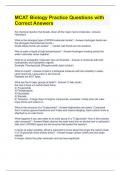
MCAT Biology Practice Questions with Correct Answers
the chemical reaction that breaks down all the major macro-molecules - Answer-Hydrolysis What is the strongest type of INTER-molecular bonds? - Answer-Hydrogen bonds are the strongest intermolecular bonds.... diople-dipole bonds are weaker. . . Vander wall bonds are the weakest. Why is water a liquid at high temperatures? - Answer-Hydrogen bonding bonds the water molocules closer together. What is an ampipathic molecule? give an Example. - Answer-A molecule with both hydrophobic and hy...
- Exam (elaborations)
- • 38 pages •
the chemical reaction that breaks down all the major macro-molecules - Answer-Hydrolysis What is the strongest type of INTER-molecular bonds? - Answer-Hydrogen bonds are the strongest intermolecular bonds.... diople-dipole bonds are weaker. . . Vander wall bonds are the weakest. Why is water a liquid at high temperatures? - Answer-Hydrogen bonding bonds the water molocules closer together. What is an ampipathic molecule? give an Example. - Answer-A molecule with both hydrophobic and hy...
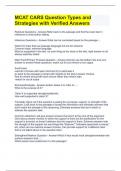
MCAT CARS Question Types and Strategies with Verified Answers
Retrieval Questions - Answer-Refer back to the passage and find the exact text in reference to what author stating Inference Questions - Answer-What can be concluded based on the passage.... Watch for traps that use passage language but are too extreme Common traps: extreme language Must be supported in the text, no such thing as too close to the text, right answer is not always explicitly stated Main Point/Primary Purpose Question - Answer-Actively use the bottom line and your answe...
- Exam (elaborations)
- • 2 pages •
Retrieval Questions - Answer-Refer back to the passage and find the exact text in reference to what author stating Inference Questions - Answer-What can be concluded based on the passage.... Watch for traps that use passage language but are too extreme Common traps: extreme language Must be supported in the text, no such thing as too close to the text, right answer is not always explicitly stated Main Point/Primary Purpose Question - Answer-Actively use the bottom line and your answe...
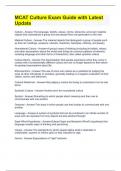
MCAT Culture Exam Guide with Latest Update
Culture - Answer-The language, beliefs, values, norms, behaviors, and even material objects that characterize a group and are passed from one generation to the next Material Culture - Answer-The material objects that distinguish a group of people such as their art, buildings, weapons, utensils, machines, hairstyles, clothing, and jewelry Nonmaterial Culture - Answer-A group's ways of thinking (including its beliefs, values, and other assumptions about the world) and doing (its common patt...
- Exam (elaborations)
- • 3 pages •
Culture - Answer-The language, beliefs, values, norms, behaviors, and even material objects that characterize a group and are passed from one generation to the next Material Culture - Answer-The material objects that distinguish a group of people such as their art, buildings, weapons, utensils, machines, hairstyles, clothing, and jewelry Nonmaterial Culture - Answer-A group's ways of thinking (including its beliefs, values, and other assumptions about the world) and doing (its common patt...

MCAT enzymes Exam Questions with Verified Answers
Enzyme - Answer-Biological catalyst Lower activation energy Increase rate of reaction Are not changed or consumed during reaction pH and temperature sensitive Do not affect overall Delta G Specific for a particular reaction or class of reactions Do not change equilibrium of a reaction Urease - Answer-Catalyzes the breakdown of urea Oxidoreductases - Answer-Catalyze oxidation-reduction reactions, transfer of electrons between biological molecules. Often require cofactors that acts as...
- Exam (elaborations)
- • 5 pages •
Enzyme - Answer-Biological catalyst Lower activation energy Increase rate of reaction Are not changed or consumed during reaction pH and temperature sensitive Do not affect overall Delta G Specific for a particular reaction or class of reactions Do not change equilibrium of a reaction Urease - Answer-Catalyzes the breakdown of urea Oxidoreductases - Answer-Catalyze oxidation-reduction reactions, transfer of electrons between biological molecules. Often require cofactors that acts as...
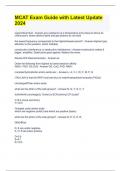
MCAT Exam Guide with Latest Update 2024
supercritical fluid - Answer-any substance at a temperature and pressure above its critical point, where distinct liquid and gas phases do not exist the lowest frequency corresponds to the highest/lowest period? - Answer-highest (pay attention to the question, dumb mistake) constructive interference vs destructive interference - Answer-constructive makes it bigger, amplifies. Destructive goes against, flattens the wave. Review R/S Stereochemistry - Answer-ok Order the following from ...
- Exam (elaborations)
- • 100 pages •
supercritical fluid - Answer-any substance at a temperature and pressure above its critical point, where distinct liquid and gas phases do not exist the lowest frequency corresponds to the highest/lowest period? - Answer-highest (pay attention to the question, dumb mistake) constructive interference vs destructive interference - Answer-constructive makes it bigger, amplifies. Destructive goes against, flattens the wave. Review R/S Stereochemistry - Answer-ok Order the following from ...
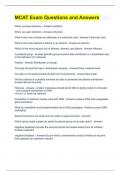
MCAT Exam Questions and Answers
When you lose electrons - Answer-oxidation When you gain electrons - Answer-reduction What is the most oxidized an aldehyde or a carboxylic acid - Answer-Carboxylic acid What is the most reduced a ketone or an alcohol - Answer-An alcohol Which is the most reduced out of alkanes, alkenes, and alkyne - Answer-Alkanes Functional group - Answer-Specific group of atoms that contributes in a predictable way to the behavior of a molecule Polarity - Answer-Distribution of charge The...
- Exam (elaborations)
- • 1 pages •
When you lose electrons - Answer-oxidation When you gain electrons - Answer-reduction What is the most oxidized an aldehyde or a carboxylic acid - Answer-Carboxylic acid What is the most reduced a ketone or an alcohol - Answer-An alcohol Which is the most reduced out of alkanes, alkenes, and alkyne - Answer-Alkanes Functional group - Answer-Specific group of atoms that contributes in a predictable way to the behavior of a molecule Polarity - Answer-Distribution of charge The...
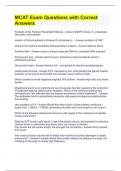
MCAT Exam Questions with Correct Answers 2024
Products of the Pentose Phosphate Pathway - Answer-NADPH, ribose- 5 - phosphate , Glycolytic intermediates reaction of G-6-phosphate to ribulose-5- phosphate is.. - Answer-oxidation of G6P where is the pentose phosphate pathway likely to happen - Answer-adipose tissue Southern Blot - Answer-used to analyze extracted DNA for a potential DNA segment Strong lewis acid - Answer-electron poor- fostered by being bonded to electron withdrawing groups strong lewis base - Answer-electron r...
- Exam (elaborations)
- • 2 pages •
Products of the Pentose Phosphate Pathway - Answer-NADPH, ribose- 5 - phosphate , Glycolytic intermediates reaction of G-6-phosphate to ribulose-5- phosphate is.. - Answer-oxidation of G6P where is the pentose phosphate pathway likely to happen - Answer-adipose tissue Southern Blot - Answer-used to analyze extracted DNA for a potential DNA segment Strong lewis acid - Answer-electron poor- fostered by being bonded to electron withdrawing groups strong lewis base - Answer-electron r...
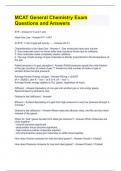
MCAT General Chemistry Exam Questions and Answers
STP - Answer-0°C and 1 atm Ideal Gas Law - Answer-PV = nRT At STP, 1 mol of gas will occupy ... - Answer-22.4 L Characteristics of an Ideal Gas - Answer-1. Gas molecules have zero volume 2. Gas molecules exert no forces other than repulsive forces due to collisions 3. Gas molecules make completely elastic collisions 4. The avg. kinetic energy of gas molecules is directly proportional to the temperature of the gas Partial pressure of a gas (equation) - Answer-Partial pressure equa...
- Exam (elaborations)
- • 20 pages •
STP - Answer-0°C and 1 atm Ideal Gas Law - Answer-PV = nRT At STP, 1 mol of gas will occupy ... - Answer-22.4 L Characteristics of an Ideal Gas - Answer-1. Gas molecules have zero volume 2. Gas molecules exert no forces other than repulsive forces due to collisions 3. Gas molecules make completely elastic collisions 4. The avg. kinetic energy of gas molecules is directly proportional to the temperature of the gas Partial pressure of a gas (equation) - Answer-Partial pressure equa...
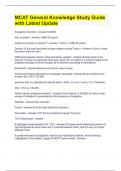
MCAT General Knowledge Study Guide with Latest Update Q&A
Avogadro's Number - Answer-6.02E23 amu in grams - Answer-1.66E-24 grams weight of a proton or neutron? - Answer-1 amu or 1.66E-24 grams Carbon-12 the most abundant isotope weighs exactly? (amu) - Answer-12 amu, it was the bench mark for amu. Difference between atomic mass and atomic weight? - Answer-Atomic mass is the amount of mass of a particular atom say carbon-12, or carbon-13. Atomic weight is the weighted average of all the isotopes of an element according to abundance. Ele...
- Exam (elaborations)
- • 2 pages •
Avogadro's Number - Answer-6.02E23 amu in grams - Answer-1.66E-24 grams weight of a proton or neutron? - Answer-1 amu or 1.66E-24 grams Carbon-12 the most abundant isotope weighs exactly? (amu) - Answer-12 amu, it was the bench mark for amu. Difference between atomic mass and atomic weight? - Answer-Atomic mass is the amount of mass of a particular atom say carbon-12, or carbon-13. Atomic weight is the weighted average of all the isotopes of an element according to abundance. Ele...
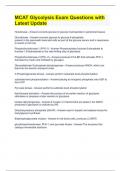
MCAT Glycolysis Exam Questions with Latest Update
Hexokinase - Answer-converts glucose to glucose 6-phosphate in peripheral tissues Glucokinase - Answer-converts glucose to glucose 6-phosphate. present in the pancreatic beta islet cells as part of the glucose sensor and is responsive to insulin in the liver Phosphofructokinase-1 (PFK-1) - Answer-Phosphorylates fructose 6-phosphate to fructose 1,6-biphosphate in the rate limiting step of glycolysis Phosphofructokinase-2 (PFK- 2) - Answer-produces F2,6-BP that activates PFK-1. Activa...
- Exam (elaborations)
- • 1 pages •
Hexokinase - Answer-converts glucose to glucose 6-phosphate in peripheral tissues Glucokinase - Answer-converts glucose to glucose 6-phosphate. present in the pancreatic beta islet cells as part of the glucose sensor and is responsive to insulin in the liver Phosphofructokinase-1 (PFK-1) - Answer-Phosphorylates fructose 6-phosphate to fructose 1,6-biphosphate in the rate limiting step of glycolysis Phosphofructokinase-2 (PFK- 2) - Answer-produces F2,6-BP that activates PFK-1. Activa...
